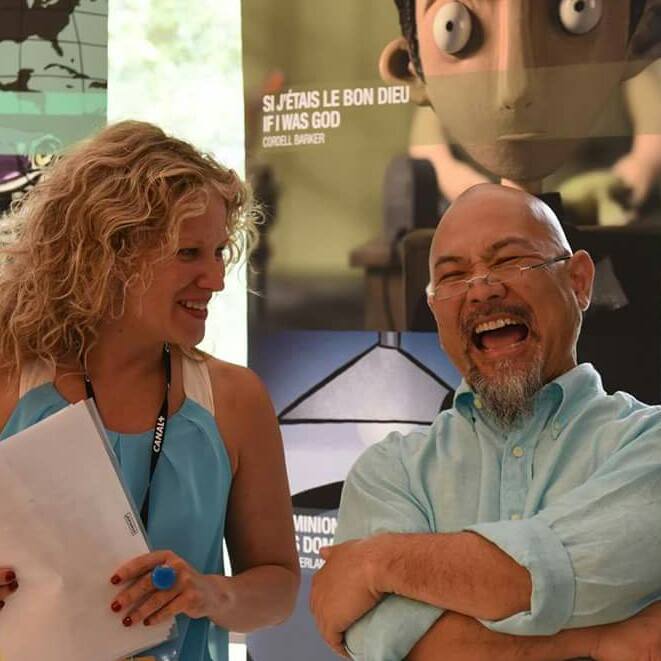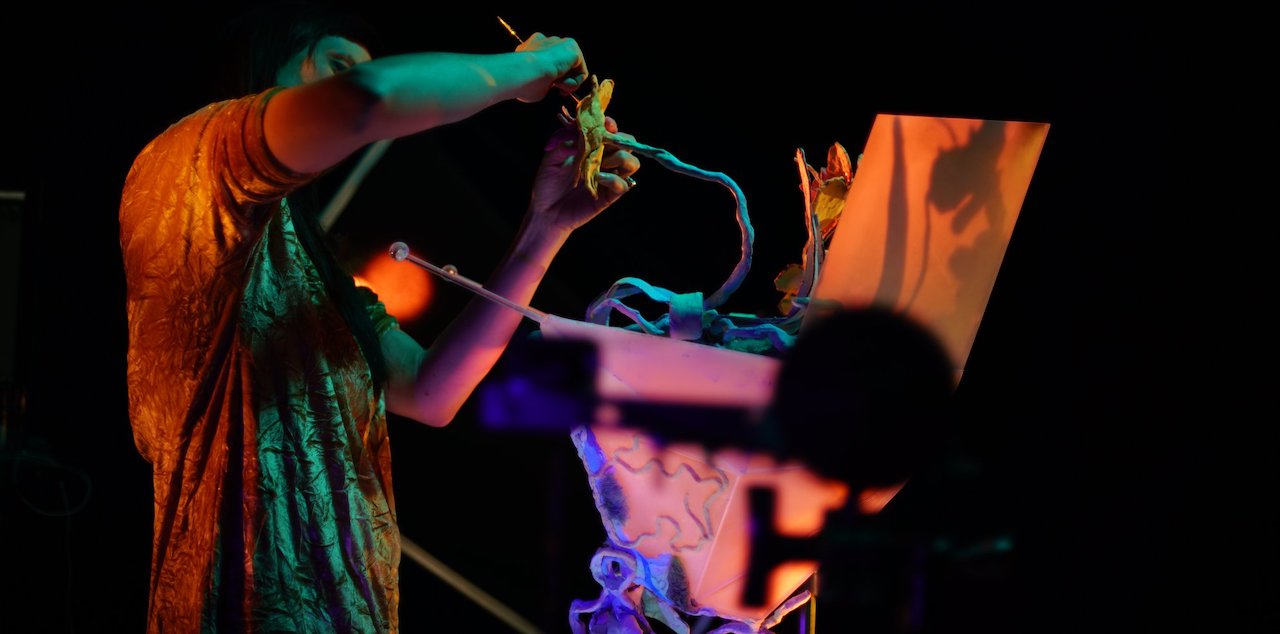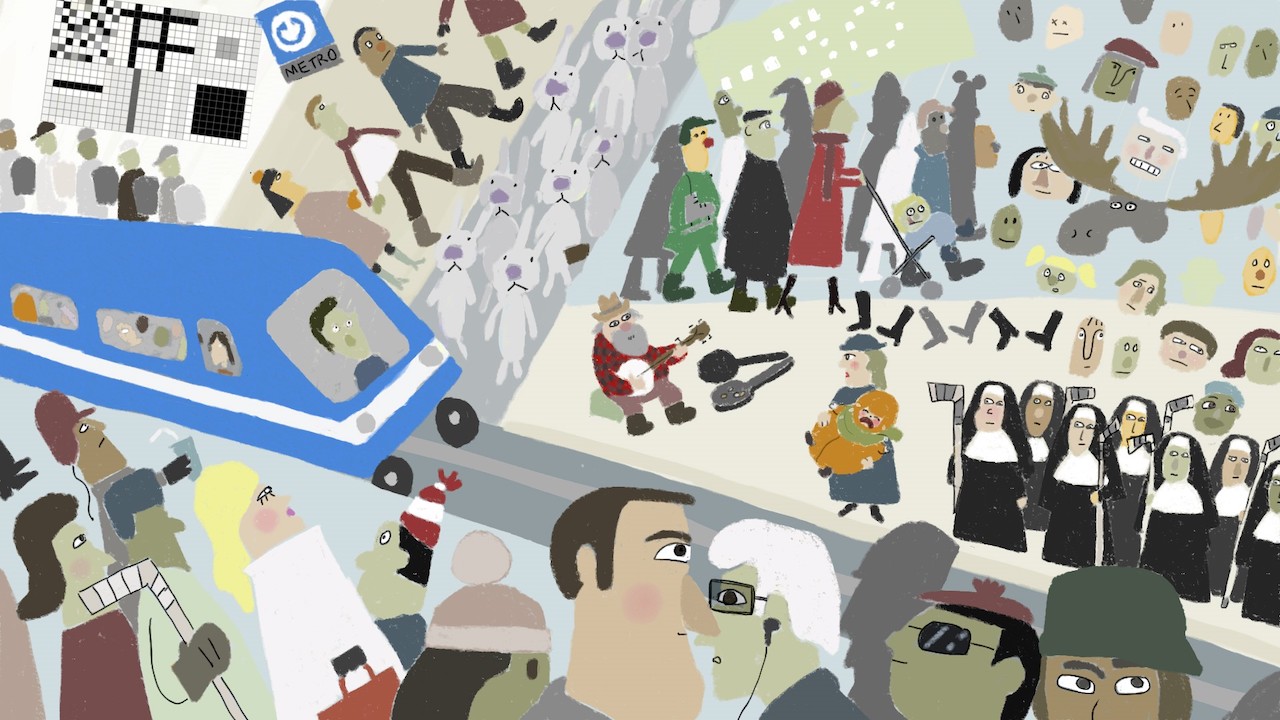

The NFB Interview, Part One: How To Make A Short Film With The Organization
I never visited the National Film Board of Canada’s fabled old studio out in the Montreal suburbs, but I’ve toured it vicariously through all the anecdotes: the abysmal food, the bleak trudges to the bus stop, the furtive goings-on in the edit suite. The building, which the NFB has mostly vacated, retains a hold on the collective imagination of its artists, who speak about it often. Maybe one day, one of them will recreate the place in virtual reality.
For now, the public institution is focused on the future, as it slowly settles into its gleaming new headquarters in the city’s downtown (see image above). The NFB occupies four floors of the glass-coated edifice, two of which are dedicated to its animation division. When I visited in early December, several filmmakers and much of the staff had moved in. Artwork, technical equipment, and antique furniture were starting to fill the building and erode its corporate sheen.
The NFB is the most prominent producer of artistic animated shorts today, and any major shake-up in its operations has consequences for this world. As it happens, the move — years in the planning — comes at a time of great change. The wider animation industry in Montreal, where the organization has been based since 1956, is booming. Meanwhile, systemic problems with the NFB’s budgeting have come to a head, with hundreds of its filmmakers recently revolting against the management.
The animation division is split into two studios: the English and French programs. The studios are editorially independent, although they share staff and branding, and all their films are released bilingually. They are led respectively by Michael Fukushima and Julie Roy, who, as executive producers, determine the slates and strategic visions of their programs.
During my visit, Fukushima and Roy sat down for their first ever joint interview, which we’re publishing in two parts. Below, they tell me what it takes to become an animation filmmaker at the NFB. In the forthcoming second part, we discuss recent changes at the organization and in the industry. True to their working habits, Fukushima spoke in English and Roy in French (her answers have been translated).

Say you’re a young filmmaker who wants to propose a project to the NFB. How can you go about doing that?
Michael Fukushima: In [the English] studio, we have a longstanding apprenticeship program called Hothouse. In 2020, we’ll be launching our “Lucky 13th” edition. We do a call across the country and six emerging animation filmmakers come. They spend 12 weeks and make a one-minute film. Otherwise we have a lovely new production website that explains how to make a submission. We welcome all sorts of submissions, we review everything.
The English animation studio has a national mandate, so we have a responsibility to work with animation filmmakers clear across the country. In some cases, those filmmakers will come here for short periods of time. Back in my day, it meant a filmmaker moving to Montreal. That’s how I started here: I left Toronto and came to Montreal to make a film. [Author’s note: Fukushima joined the NFB in 1990 to direct his first film Minoru: Memory of Exile.]
Are there regional quotas in place?
Fukushima: No, there are no firm quotas. We have limited resources, so it’s a question of what filmmakers we can work with in any given year. The circumstance we had with Alison Snowden and David Fine on Animal Behaviour was: Because they’re based in Vancouver, they worked from their home, but we had regular virtual meetings. They came to Montreal several times, I went to Vancouver. Digital has made that sort of remote workflow quite facile.
Julie Roy: We have a different initiative called Cinéaste recherché(e). There have been 23 editions so far. We do a call for entries from people who are making their first professional film, and choose one candidate. That person then comes to work here a bit like regular directors, but with more supervision, more help with the script. They are given mentors, who integrate them into the NFB’s world and stay with them throughout their project.
We also have a program called ACIC, which supports independent Canadian cinema. These aren’t NFB productions, but we give independent filmmakers access to our technical services, and charge them only 10% of the value. I run ACIC, and through it I discover young talents.
Over the years, I’ve realized that we’re becoming less and less dependent on programs to find new talent. Through ACIC, I’ve noticed that there’s been a massive increase in young independent filmmakers.
Another point: we’ve really come to see in recent years that people don’t necessarily make their first animated film while young, in their twenties. Some do it after establishing themselves as illustrators, graphic designers, or comic strip artists. I’m thinking of Pascal Blanchet who co-directed The Procession, or Catherine Lepage (Le mal du siècle), or Michèle Lemieux (Here and the Great Elsewhere).
In your slates, how consciously do you strive for a balance between established NFB directors and new talents? Are there quotas?
Roy: In contrast to the gender parity initiative, the NFB doesn’t impose quotas on new talent. That said, it’s extremely important to make space for new talent. Of the 19 projects currently in the works in my studio, ten, or 53%, represent first-time collaborations. Of these ten, seven are the director’s first professional film — a significant proportion.
So, yes, there’s a conscious desire to bring in new voices in our day-to-day work as producers, which is to discover talent and ensure that there’s a diversity of auteurs within the studio. This is the duty of a public institution like ours. We want young directors to work alongside those in mid-career and veterans who can kind of supervise them, set an example; we hope this can help motivate our filmmakers.
Fukushima: One of the NFB’s principal mandates is to both nurture and sustain Canadian filmmakers. So, whilst there are no fixed quotas per se, we are always conscientious about the balance of our slate every year. Talent renewal is important, but continuity of creators helps sustain the sense of community which is a fundamental piece of this studio.
Historically, I’d say we hover around 20% of our slate being with well-established filmmakers, 40% with mid-career artists, and 40% with young or new-to-NFB creators. In addition to the established/emerging dynamic, we’re always conscientious about gender parity and diversity.
To what extent do you actively scout for talent online and at festivals?
Roy: In festivals, a lot. By internet… Pascal Blanchet applied to Cinéaste recherché(e). He didn’t get it, but his graphic portfolio was really impressive. Then, yes, I searched him on the internet, and we arranged to meet. I was going to say “no” about online, but in this case…
Fukushima: For crew, we regularly frequent social media, Instagram, because we’re looking for a specific kind of artistic talent. For filmmakers, Instagram is not an ideal platform for us. Our greatest successes have been meeting filmmakers at festivals, seeing their film, gauging their filmmaking abilities and potential, and engaging in a relationship based on that.
And, you know, the one-on-one contact also helps the producer gauge the interpersonal relationship with the filmmaker. Some filmmakers are enormously talented, but maybe they’re not even interested in working with a producer. That’s good to know early on.

The NFB is a public organization, which brings certain obligations and constraints. What kind of filmmaker would not be a good fit for you?
Fukushima: We have a legacy of filmmaking that we very consciously respect, and so there is a kind of filmmaker, for sure. We’re looking for auteurs; we are generally art-driven as opposed to content-driven, so poets rather than novelists, short-story writers versus journalists. Those are my shorthands.
My colleagues in [the NFB’s documentary department] are of course content-driven, so they’re more interested in the idea and the story. I’m really interested in interesting artists that want to say something that I think will resonate with me, and with an audience. We can’t do tv series, we generally can’t do feature films — those are just logistical issues.
Roy: I agree. We look for auteurs first, before projects. We never get a project and start it as it is — we rework it. What’s different about being a producer at the NFB — and it’s both a privilege and a responsibility — is that, unlike private producers, who have to go get money from funds and institutions, we’re self-financed. What this means is that, as producers, we’re very involved in the content. We’re creative producers, not just financial administrators.
This doesn’t work for some directors, who have an independent spirit and don’t want to share the editorial side with another “authority,” the producer. For international co-productions, we can’t have someone come to us near the end of a project and ask if we want to complete the financing. We need to be involved from the start, give feedback on the script, be listened to. We become a part of the team.
“Auteur” is a word I’ve seen often in the NFB’s official literature. I wonder what that word means for you in the context of the collaborative medium that is animation.
Roy: For me, an auteur is someone with a strong personality, in terms of visual style and storytelling. Someone with something to communicate. We have a very artisanal model: our directors do pretty much everything. We follow the McLaren model, where the auteur is the orchestra conductor — the writer, the director, sometimes even the editor. The vast majority are animators themselves, and they work with micro-teams. [Author’s note: the pioneering experimental filmmaker Norman McLaren founded the NFB’s animation division in 1941.]
Fukushima: “Auteur” and “artisanal” are deeply connected in the way we define them. There’s a hand-craftedness to NFB films that’s crucial to our philosophy. Yes, filmmaking is entirely a collaborative effort. The best auteur filmmakers are those who are self-confident enough in what they need to say, and how they need to say it, that they can listen to anybody and accommodate almost anything. But they know where the line is — where suddenly it’s no longer their film, and it’s moved slightly into the committee area.

To what extent do the two of you define the strategies of your studios in relation to what the other is doing?
Fukushima: I would say not consciously. We’re in a unique era right now. Since Julie and I have been the heads of our respective studios, we have shared common spaces. Up until 19 years ago, the two studios were physically quite separated from each other, so there was virtually no integration or cooperation at all.
Julie and I share many belief sets, philosophical overviews of what the NFB should be, how we should operate. So, instinctively, the two slates — I think — are complementary. But it’s not a conscious decision. It’s quite natural and organic, and based on our personalities and interpersonal relationship: Julie and I are friends and colleagues.
Roy: Michael has been here for 30 years, me 25 years. We’re products of the NFB: we understand its mission, its DNA. But while there are two studios, I “belong,” in a structural sense, to the French one, which also has its own culture, as does the English studio. The language is already one difference. We establish our strategies separately. We meet a lot, but not necessarily to say, “What are you planning for the next three years?” I think we cultivate our differences, and in the long run we complement one another.
(This text has been lightly edited for brevity and clarity. Image at top © Devisubox/SHDM.)
